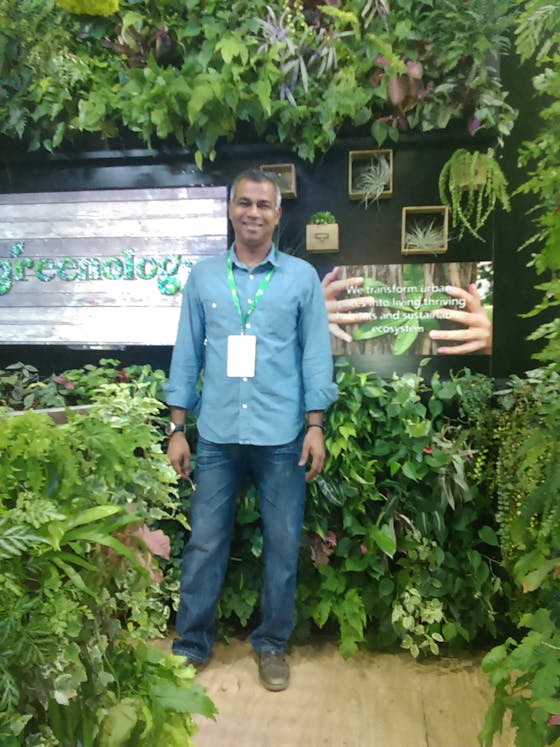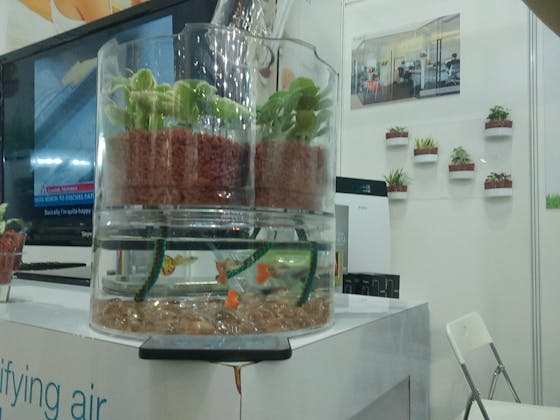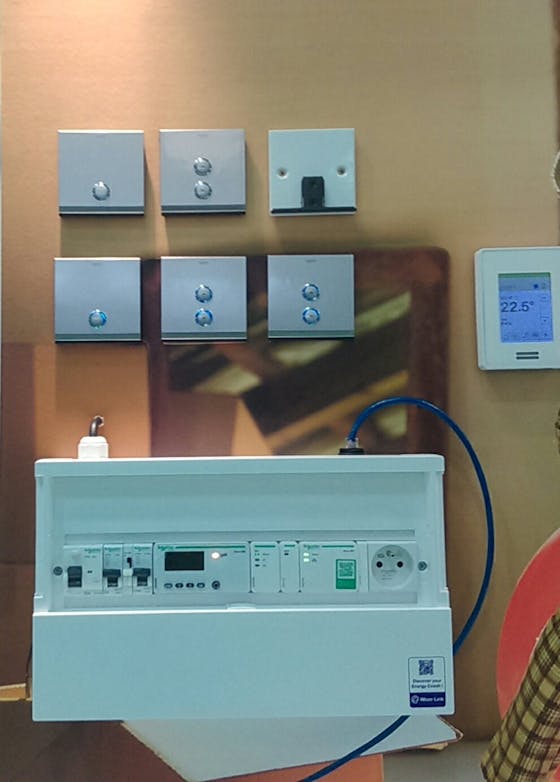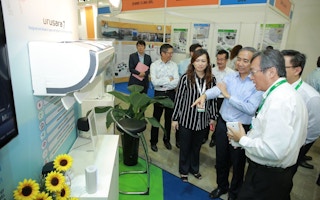Dubbed the premier trade show for the green building sector, the annual Build Eco Xpo (BEX Asia) this year features offerings that go beyond industry solutions to show high-tech green products - such as green walls, air purifying potted plants, home energy savings systems - that are accessible to the average consumer too.
This is in line with the latest evolution of the Building and Construction Authority’s (BCA) green building drive, Ang Kian Seng, BCA’s group director for technology development, tells Eco-Business.
BCA’s third Green Building Masterplan, released in September 2014, included provisions to actively engage building tenants and occupants. The Green Mark for Office Interior scheme, for example, is intended to drive building occupants’ green behaviour by encouraging them to install sustainable and environmentally friendly features.
“This is an opportune time for all building users to embrace and appreciate the benefits of consumers’ green products,” Mr Ang says.
Eco-Business highlights a few user-friendly green products from this year’s show.
No green thumb? No worries
For every home or business owner who cherishes a miniature garden in their residence or workplace, there are five or six more who feel that the hassle of looking after plants outweighs whatever benefits greenery may bring.
“People get put off by having potted plants,” says Veera Sekaran, the founder and managing director of Singapore-based urban greening specialist firm Greenology.

Veera Sekaran, founder of Greenology with one of the company’s green walls. Image: Eco-Business
“They feel that they cannot go on holiday, or the plant will die from neglect. Some people will not even entertain the idea of having a plant around, because they feel that they have no green thumb.”
To help overcome this aversion, Greenology designed a series of green walls that are almost completely self-maintained. The green walls integrate aesthetics and convenience, incorporating hardy but attractive tropical ferns and other plants that can thrive in a wide range of conditions. Each wall is built on a substrate panel that incorporates all the systems needed for a plant to survive: LED lighting, self-irrigation mechanics, even inbuilt fertiliser.
Time has already proven the concept, as some of Greenology’s green walls have already lasted four or five years with show no signs of wilting.The idea, says Sekaran, is to remove the stress of having to care for the plant, as everything is done automatically.
And the concept is catching on: over the last few years, the firm has seen a steady increase in both corporate and residential customers.
The idea of a self-contained, low-maintenance system that takes care of itself has even percolated into tertiary education.
At the “Green Thinking: A Designer’s Residence” exhibition by Ngee Ann Polytechnic’s School of Design and Environment, one design concept by student Hansel Kuntadi integrated a rainwater harvesting system with an eco-pond and a garden, such that no filtration system is required.
Air purification in a pot
For those who are daunted by the prospect of an entire green wall, a smaller cousin is available in the form of research and manufacturing firm In Vitro’s Plant Sushi, a tiny, low-maintenance plant bedded down in a self-watering pot.
The real value of the pot is not in the plant’s decorative properties, however, but in the potting material: porous stones containing genetically tailored microbes that filter harmful chemicals from the air. Larger pots are also available, capable of housing multiple plants and even doubling up as a fish tank – though the fish do need more care than the plant alone would.

Fancy a plant sushi? Image: Eco-Business
Each Plant Sushi retains its air purification ability for about six months, after which it can continue as a desk decoration.
Convenient installation
As green technology becomes more widely implemented, the concept of user convenience has expanded from ease of use alone to ease of maintenance and installation.
For example, Schneider Electric’s booth showcased a home system for smart energy management that is designed to be installed with as little disruption as possible. At its most basic level, the system features retrofittable dimming and brightening switches that can replace mechanical switches with no additional wiring work required.
This is significant, as most other dimming products only work if a neutral wire is added to the switch mechanism, incurring extra work and expense.
The system also allows users to control home electronics such as televisions and air conditioners through a mobile app. One additional device is required: a small, installation-free remote converter that can be placed anywhere in the vicinity of the appliances.
It comes pre-loaded with television and air conditioner remote codes, and can even “learn” the codes of unfamiliar appliances, so that the user need not do anything at all – simply put it in a convenient place, and it will work with no further action required.

The energy management system from Schneider Electric. Image: Eco-Business
A question of mindset
While innovators and developers are doing their best to make green technology convenient, not everything can be consumer-friendly as yet. One example is the on-site food waste digester developed by waste management firm BioHitech America and brought here by water treatment specialist Flexi Systems. The digester converts food waste into liquid that can be safely discharged into the sewers.
But the 500-kilogramme machine, whose smallest version is almost 1.3 metres tall and occupies slightly over a square metre of floor area, has a weakness: plastic, metal, and other non-biodegradable items. If cutlery, coffee stirrers, and the like are not separated out before the food waste is deposited inside, the digester will have a severe case of indigestion.
Food waste separation is still considered a hassle here, and unsurprisingly, many people would prefer to dispose of their food waste in a more fuss-free way, even if that means paying disposal fees or running a higher chance of polluting the environment.
“The issue is people’s mentality,” says Owen Yeo, who is in charge of business development for Flexi Systems. “There is a cultural mindset here where people will complain that it’s too troublesome to sort your waste out.”
“But in Taiwan, for instance, if you don’t sort your waste before binning it, other people will scold you for being inconsiderate!,” he says.
There is no quick and easy solution to this particular problem, he feels: only time and education will make environmentally-friendly consumer actions into a social norm, and it will only happen in stages.
“Today, at some hawker centres, you see cleaners separating out paper cups into a different bag [for recycling]. They still don’t separate the plastic scraps. But ten years ago, they wouldn’t even bother with the cups. You have to take baby steps.”
Five of the food waste digesters are installed at Marina Bay Sands, so there is a fair chance that the next time you attend an event at the Sands Convention Centre, the food waste from your lunch or tea break will be processed by one of them.
Click here for more information on Build Eco Xpo (BEX Asia), Southeast Asia’s premier platform for the green building and construction industry. It is held at Marina Bay Sands from 2 to 4 September 2015.
Eco-Business is producing a special e-newsletter featuring stories on the proceedings at IGBC 2015. Sign up to receive the newsletter here.









